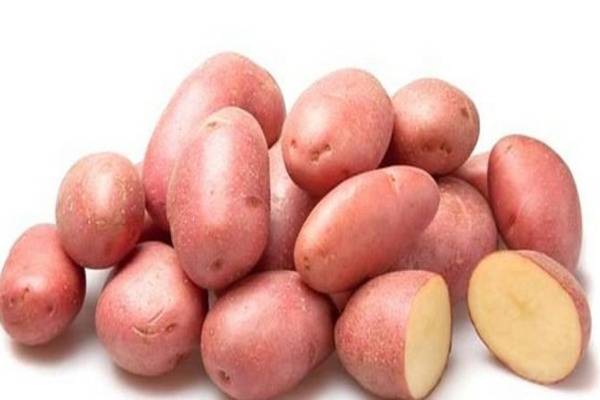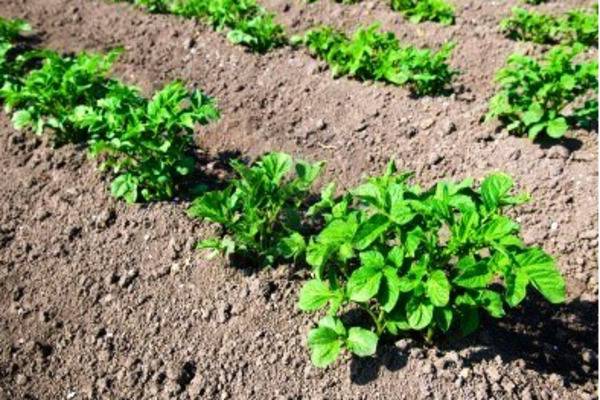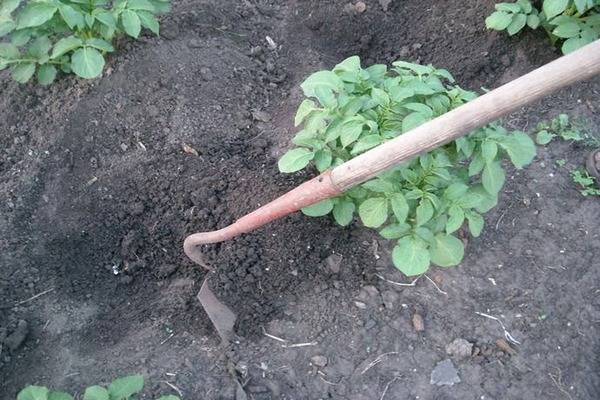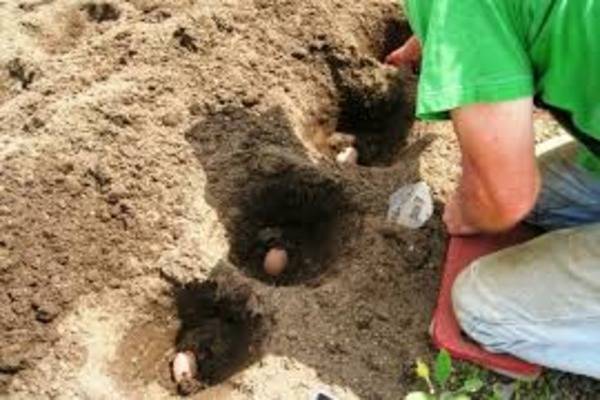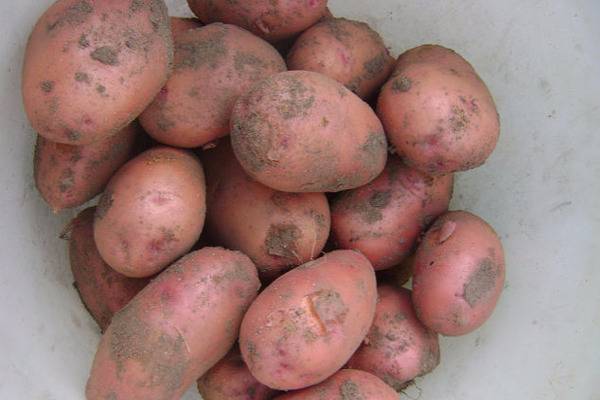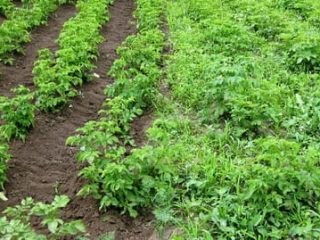Content
Potatoes of the Rosalind variety are the product of the work of German breeders. Recommended for cultivation in several regions: Central, East Siberian, Central Black Earth, North Caucasus.
Description
Early potato Rosalind bushes are semi-erect and of medium height. The bright green, open leaves grow medium in size.
Tubers ripen weighing 60-110 g, and up to 16 potatoes can form in one bush. The oval-round fruits are distinguished by a smooth red skin and yellowish pulp (as in the photo). Starch content 12.2-17%. It takes 53-61 days for the crop to ripen. The Rosalind variety is distinguished by excellent keeping quality (95-97% of tubers are preserved).
If you pre-germinate the planting material, the rate of tuber ripening increases. Therefore, it is not surprising that in the southern regions experienced gardeners harvest twice a season.
Advantages and disadvantages
When characterizing Rosalind potatoes, it is easy to highlight the positive and negative aspects of the variety.
Advantages |
|
Flaws | Susceptibility to late blight. Preventive measures - processing potatoes before planting. Experienced gardeners also recommend disinfecting the soil. |
Landing
An important guarantee of a bountiful harvest is fertile soil. For Rosalind potatoes, loose, well-ventilated and moist soils are more suitable.
Preparatory stage - disinfection of planting material and soil:
- Tubers are treated with special means. "Colfugo Super" is a liquid seed protectant. Neutralizes many diseases, has a long period of action, promotes the friendly emergence of seedlings, and is not phytotoxic. The product adheres well to the surface of the tubers - it is resistant to being washed off with water (during watering or during rains). Consumption rate – 2 ml per kilogram of potatoes. It is to combat late blight that Fitosporin-M is used. Consumption – 10 ml per kilogram of material.
- “Force” or “Aktar” are used for cultivating the land. These products disinfect the soil and help fight wireworms after planting the potatoes. The recommended dose is 0.5 kg per hundred square meters.To simplify the processing process, it is better to scatter the granules while planting the tubers (the product should be located near the root system of the plants).
Planting work is carried out after the threat of frost. The soil temperature at a depth of 8-10 cm should be at least + 5-8˚С. Rows of Rosalind potatoes are best placed in a north-south direction. Holes 8-10 cm deep are dug with a distance of 65-70 cm between rows and a step of 25-30 cm in a row.
Care
Rosalind is one of the varieties that quickly respond to high-quality agricultural technology. And this should not be neglected, because with proper care, productivity increases by 15-20%. The following activities should be carried out regularly:
- weeding;
- shallow loosening, which increases the air conductivity of the soil;
- hilling;
- application of fertilizers.
The bushes should not be flooded. To ensure that water flows well to the roots of the Rosalind potato variety, it is advisable to make grooves parallel to the rows.
Hilling and feeding
These are the most necessary procedures, without which it is difficult to expect a good harvest. It is recommended to do this work in cloudy weather when the ground is wet.
Hilling rules
When hilling the Rosalind potato bush, the moist soil is raked to the roots. This procedure will allow you to get maximum yield, as it promotes the formation of new tubers. An additional effect is provided by loosening the soil around the plants, during which the soil is saturated with air and dries out more slowly. The Rosalind variety of potatoes is earthed up for the first time after emergence. During the season, bushes are usually spudded twice with an interval of three to three and a half weeks.
How to feed potatoes
Gardeners who prefer organic fertilizers can use half-rotted manure or composts (a mixture of peat and manure). If you immediately pour wood ash into a hole or trench, you can get a greater effect. An excellent crop of potatoes of the Rosalind variety also ripens when using inorganic fertilizers.
Nutrient compositions are added in several stages. It is important to choose the appropriate mixture for each time.
- The first time fertilizing is added to the soil after germination. Nitrogen-containing compounds such as ammonium sulfate and ammonium nitrate are used. Since potatoes of the Rosalind variety should quickly grow green mass. You can use a solution of 15 g of urea and 500 ml of mullein per 10 liters of water.
- As soon as buds appear and tubers begin to set, the plants are fertilized again. At this time, Rosalind's potatoes need potassium and phosphorus. Therefore, a mixture of 15 g of potassium sulfate, half a glass of wood ash, 15 g of superphosphate, diluted in 10 liters of water, is suitable.
- Three weeks before digging up Rosalind potatoes, the soil is fertilized with a solution of superphosphate (30 g) and slurry (25 ml) diluted in a bucket of water (10 l). Approximately half a liter of fertilizer is poured under each potato bush.
Do not neglect fertilizing, especially organic. Because these additives improve the structure of the soil - they make it looser.
Diseases and pests
The main danger for the Rosalind variety is late blight, which damages the tubers and aerial parts. The first signs of damage are darkened spots on the leaves. The disease leads to the death of tops, and infected fruits rot during storage. Chemicals are a reliable means of control.Tops 25-30 cm high are sprayed with special solutions (Bordeaux mixture, copper sulfate). Before flowering, use Eksiol, Epin, if the weather is damp and cool. When it is warm and dry, you can use Krezacin, Silcom. As soon as the bushes fade and tubers begin to actively form, it is recommended to spray Rosalind potatoes with Alufit.
Preventive measures
It is known that disease is easier to prevent than to treat. This expression also applies to the plant world. The most popular preventive measures:
- plant only healthy material; do not place potato beds in damp lowlands;
- thinning the rows - very dense planting is not allowed;
- timely hilling of potato bushes of the Rosalind variety;
- If rainy weather is expected, it is advisable to dig up the potato tubers earlier.
After harvesting, it is important to carefully remove the remains of tops and tubers. It is best to burn the remaining post-harvest litter.
Harvesting
Sometimes, due to inexperience or following the advice of inexperienced neighbors, novice summer residents delay digging up potatoes. Such slowness in harvesting early varieties can lead to crop loss. The optimal time for digging up Rosalind tubers is the first half of August. But more precisely, the period is determined individually and depends on climatic conditions. Indeed, in case of rainy weather, harvesting is delayed.
The popularity of the Rosalind variety among summer residents is quite justified. Potatoes ripen early, have excellent taste, are moderately starchy and do not fall apart when cooked. Therefore, they are suitable for preparing various dishes.
Reviews
